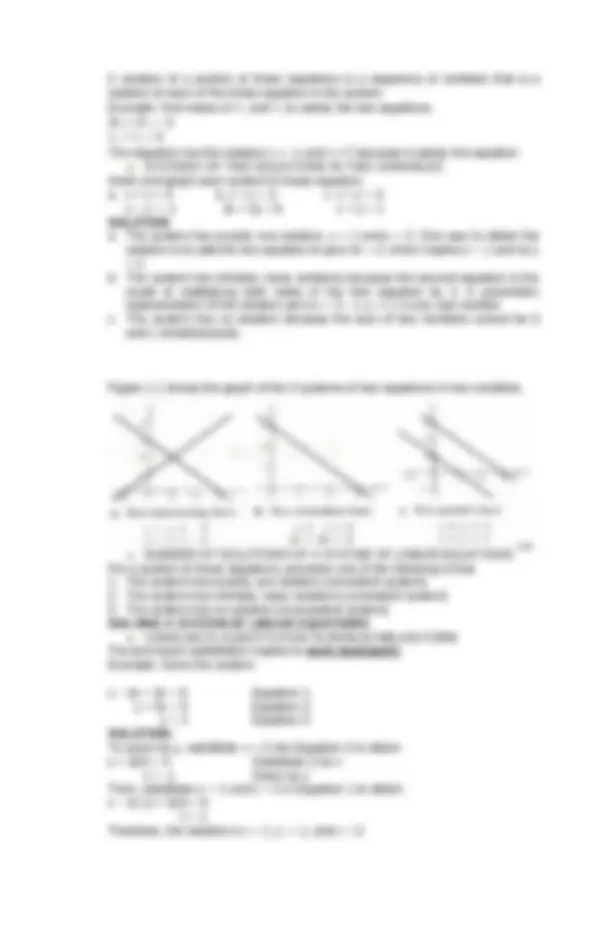




Study with the several resources on Docsity

Earn points by helping other students or get them with a premium plan


Prepare for your exams
Study with the several resources on Docsity

Earn points to download
Earn points by helping other students or get them with a premium plan
Community
Ask the community for help and clear up your study doubts
Discover the best universities in your country according to Docsity users
Free resources
Download our free guides on studying techniques, anxiety management strategies, and thesis advice from Docsity tutors
An introduction to linear algebra, focusing on classifying linear and non-linear equations, using back-substitution and gaussian elimination to solve systems of linear equations, and appreciating their importance. It covers the concept of linear equations in two and three variables, their solutions and solution sets, parametric representation of solution sets, and systems of linear equations. Examples and exercises are included.
What you will learn
Typology: Study notes
1 / 4

This page cannot be seen from the preview
Don't miss anything!



This section aims to:
a. Classify equation in n variables as to linear or non-linear.
b. Use back-substitution and Gaussian elimination to solve a system of linear
equations.
c. Appreciate the importance of solving systems of linear equations.
The study of liner algebra demands familiarity with algebra, analytic geometry
and trigonometry. Recall from analytic geometry that the equation of the line in
two-dimensional space has the form
a
1
x +
a
2
y = b where
a
1
, a
2
∧ b are constants. This is called linear equation in two
variables.
A linear equation in two variables x and y has the form
a
1
x
a
2
y = b
A linear equation in three variables x, y and z has the form
a
1
x
a
2
y + a
3
z = b
A linear equation in n variables has the form
a
1
x
1
a
2
x
2
3
x
3
n
x
n
= b
Linear equation have no product or roots of variables and no variables involved
in trigonometric, exponential, or logarithmic functions. Variables appear only to
the first power.
Example:
x
2
e
x
-2y = 4
x
2
Items 1, 2, 3 and 5 are not linear equation since it has an exponent of two which
made the equation nonlinear. On the other hand, item no.4 shows a linear
equation since it appear only to the first power.
A solution of a linear equation in n variables is a sequence of n real numbers
s
1
s
2
, s
3
, … s
n
arranged to satisfy the equation when you substitute the value.
The set of all solutions of a linear equation is called a solution set , and when
you have found this set, you have solved the equation.
Example:
Find the values of
x
1
and
x
2
to satisfy the equation.
x
1
2
SOLUTION
x
1
=2 and
x
2
= 1 satisfy the equation
x
1
2
. Some other solutions are
x
1
= -4 and
x
2
= 4 , x
1
= 0 ∧ x
2
2 , and x
1
=− 2 ∧ x
2
Parametric representation is used to describe the entire solution set of a linear
equation.
Example:
Solve the linear equation
x
1
2
x
1
2 x
2
let x
2
be t
x
1
If t = 2
x
1
x
1
If t = 3
x
1
x
1
A system of m linear equations in n variables is a set of m equations, each of
which is a linear in the same n variables.
A. Identify the following equations as to linear or non-linear equations.
e
x
3 x
2
y + 3 y
2
= 2z + 4
B. Solve the linear equation using the parametric representation.
3y - x - z = 6
C. Solve the ff. using the parametric representation and plot the points of the linear
equation.
D. Using the back substitution in row- echelon form, solve the linear system.
x + 2y + 3z = 9
x + 3y + 4z = 11